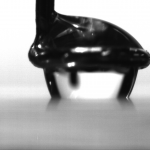The mobility of a fakir state droplet on a structured surface is fundamentally determined by the effective length of a microscopic contact line. However, it is largely unknown how the surface topography determines the effective contact line length. Based on the direct measurement of droplet adhesion force and the visualization of contact line, our work, published in Physical Review Letters under the title “Topography-Dependent Effective Contact Line in Droplet Depinning“, shows that effective contact line length is topography-dependent as opposed to prior notion. On pored surfaces, contact line is not distorted, and the effective length approaches the droplet apparent perimeter regardless of pore dimensions. On pillared surfaces, the distortion of contact line is significantly dependent on the packing density of the pillar structures so that the effective length is as small as a pillar diameter on densely-packed pillars and as large as a pillar perimeter on sparsely-packed pillars, while changing linearly between the two extremes.
This paper is the result of our long-standing collaboration with Prof. Chang-Hwan Choi fromthe Stevens Institute of Technology.
Depinning Contact Line
This entry was posted in Publications. Bookmark the permalink.

